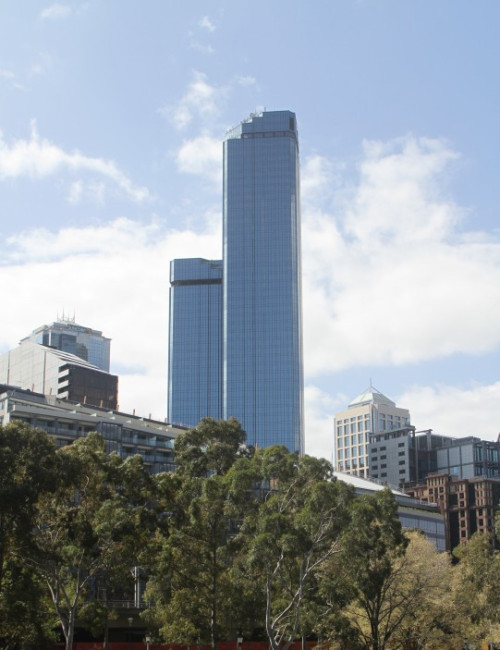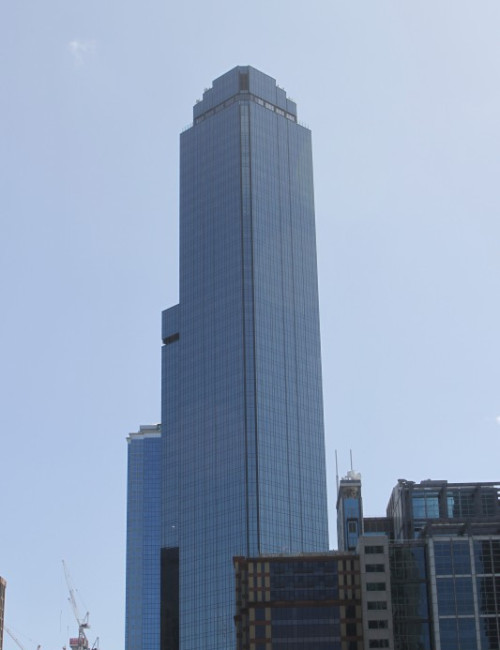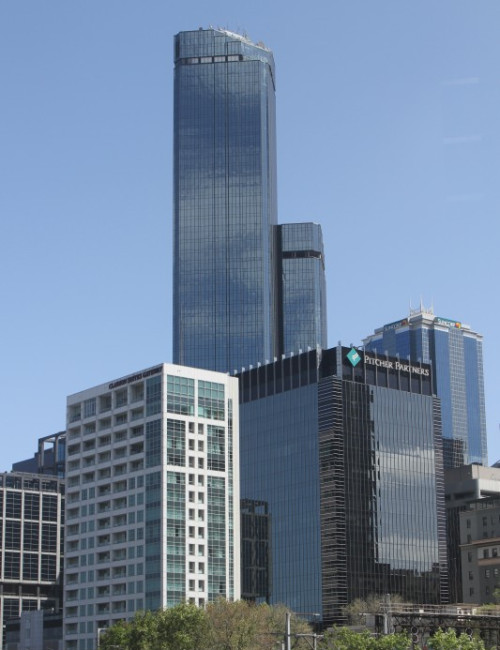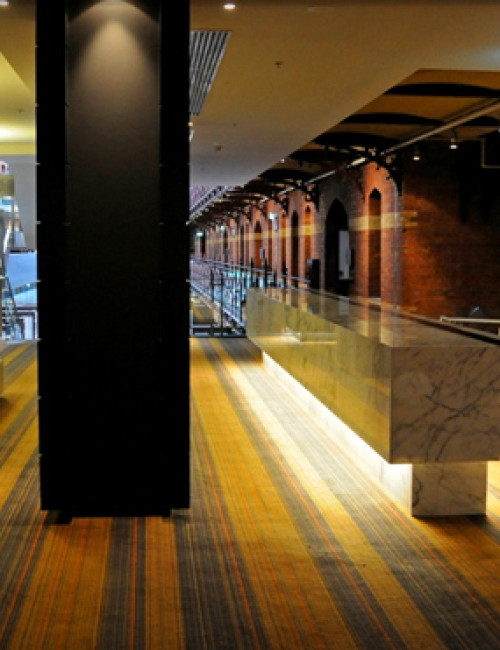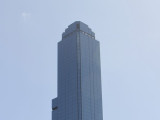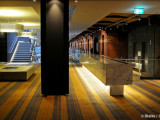Height rank
Rialto Towers
Melbourne
-
Metrics
You must be a CTBUH Member to view this resource.
Official Name
Rialto Towers
Type
Building
Status
Completed, 1986
Country
City
Address
Postal Code
3000
Function
A mixed-use tall building contains two or more functions (or uses), where each of the functions occupy a significant proportion of the tower's total space. Support areas such as car parks and mechanical plant space do not constitute mixed-use functions. Functions are denoted on CTBUH "Tallest Building" lists in descending order, e.g., "hotel/office" indicates hotel function above office function.
office
Structural Material
Both the main vertical/lateral structural elements and the floor spanning systems are constructed from steel. Note that a building of steel construction with a floor system of concrete planks or concrete slab on top of steel beams is still considered a “steel” structure as the concrete elements are not acting as the primary structure.
Reinforced Concrete
Both the main vertical/lateral structural elements and the floor spanning systems are constructed from concrete which has been cast in place and utilizes steel reinforcement bars.
Precast Concrete
Both the main vertical/lateral structural elements and the floor spanning system are constructed from steel reinforced concrete which has been precast as individual components and assembled together on-site.
Mixed-Structure
Utilizes distinct systems (e.g. steel, concrete, timber), one on top of the other. For example, a steel/concrete indicates a steel structural system located on top of a concrete structural system, with the opposite true of concrete/steel.
Composite
A combination of materials (e.g. steel, concrete, timber) are used together in the main structural elements. Examples include buildings which utilize: steel columns with a floor system of reinforced concrete beams; a steel frame system with a concrete core; concrete-encased steel columns; concrete-filled steel tubes; etc. Where known, the CTBUH database breaks out the materials used in a composite building’s core, columns, and floor spanning separately.
concrete
Height
251.1 m / 824 ft
Floors Above Ground
63
Floors Below Ground
3
# of Parking Spaces
612
# of Elevators
33
-
By function
You must be a CTBUH Member to view this resource.
-
By material
You must be a CTBUH Member to view this resource.
Structural Engineer
The Design Engineer is usually involved in the front end design, typically taking the leadership role in the Schematic Design and Design Development, and then a monitoring role through the CD and CA phases.
Material Supplier
Material Supplier refers to organizations which supplied significant systems/materials for a building project (e.g. elevator suppliers, facade suppliers, etc).
Material Supplier refers to organizations which supplied significant systems/materials for a building project (e.g. elevator suppliers, facade suppliers, etc).
You must be a CTBUH Member to view this resource.
Owner
Dexus Property Group; GIC Private Limited; Grollo Group
St Martins Property
Developer
Grollo Group; St Martins Property
Architect
Usually involved in the front end design, with a "typical" condition being that of a leadership role through either Schematic Design or Design Development, and then a monitoring role through the CD and CA phases.
Gerard de Preu & Partners; Perrot Lyon Mathieson
Structural Engineer
The Design Engineer is usually involved in the front end design, typically taking the leadership role in the Schematic Design and Design Development, and then a monitoring role through the CD and CA phases.
Project Manager
The CTBUH lists a project manager when a specific firm has been commissioned to oversee this aspect of a tall building’s design/construction. When the project management efforts are handled by the developer, main contract, or architect, this field will be omitted.
The CTBUH lists a project manager when a specific firm has been commissioned to oversee this aspect of a tall building’s design/construction. When the project management efforts are handled by the developer, main contract, or architect, this field will be omitted.
Project Planning and Management Pty Ltd
Main Contractor
The main contractor is the supervisory contractor of all construction work on a project, management of sub-contractors and vendors, etc. May be referred to as "Construction Manager," however, for consistency CTBUH uses the term "Main Contractor" exclusively.
The main contractor is the supervisory contractor of all construction work on a project, management of sub-contractors and vendors, etc. May be referred to as "Construction Manager," however, for consistency CTBUH uses the term "Main Contractor" exclusively.
Grocon
Other Consultant
Other Consultant refers to other organizations which provided significant consultation services for a building project (e.g. wind consultants, environmental consultants, fire and life safety consultants, etc).
Other Consultant refers to other organizations which provided significant consultation services for a building project (e.g. wind consultants, environmental consultants, fire and life safety consultants, etc).
Dexus Property Group
MEL Consultants Pty Ltd
Material Supplier
Material Supplier refers to organizations which supplied significant systems/materials for a building project (e.g. elevator suppliers, facade suppliers, etc).
Material Supplier refers to organizations which supplied significant systems/materials for a building project (e.g. elevator suppliers, facade suppliers, etc).
Videos

16 September 2014 | Melbourne
How Vertical Transportation is Helping Transform the Modern City
Elevators are the most important service in modern high-rise buildings, occupying more space than any other service. With increasing land and construction costs and the...
Research
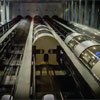
16 September 2014
How Vertical Transportation is Helping Transform the Modern City
Glen Pederick, Meinhardt Group
Elevators are the most important service in modern high-rise buildings, occupying more space than any other service. With increasing land and construction costs and the...
About Rialto Towers
When completed in 1986, Rialto Towers was the tallest office building in the Southern Hemisphere and was the first building to surpass the 200 meter threshold in Melbourne. The surrounding Rialto district was named in reference to the Venetian gothic architecture found on many of the 19th century buildings developed during the Melbourne gold rush. When the Rialto Towers was first planned in 1981, many of these older buildings from that period had already been demolished, leading to public outcry and the partial preservation of the remaining structures. The main footprint of the Rialto Towers is set into the middle and southern end of the block, preserving the scale of the historic streetscape along Collins Street. The building then rises from a podium base as two interlinked reinforced concrete towers, reaching 43 floors and 63 floors respectively.
The building rests upon 76 reinforced concrete caissons reaching up to 1.8 meters in diameter and 40 meters in below grade. The building’s concrete structure is composed of central service cores in each tower, with floor slabs spanning the distance between the core walls and the perimeter columns, proving for maximum flexibility with interior layouts. As the building approached 30 years in age, a new podium structure was designed and constructed around the base of the Rialto Towers and including a new interior atrium providing a new sheltered public space between the Collins Street sidewalks and the elevator lobbies of the office towers.
Subscribe below to receive periodic updates from CTBUH on the latest Tall Building and Urban news and CTBUH initiatives, including our monthly newsletter. Fields with a red asterisk (*) next to them are required.
View our privacy policy


